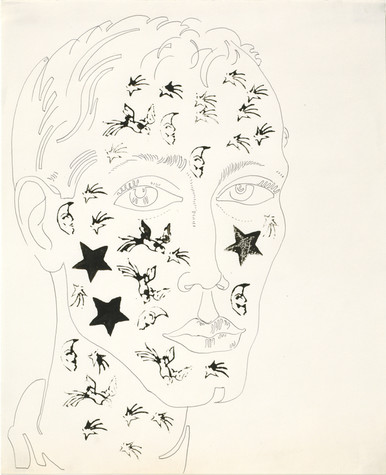The following assessments can be used for this lesson using the downloadable assessment rubric.
- Aesthetics 1
- Creative process 2
- Creative process 3
- Creative process 5
- Critical thinking 1
- Critical thinking 3
- Historical context 2

Andy Warhol, Unidentified Male (with Decorative Stamps), 1950s
The Andy Warhol Museum, Pittsburgh; Founding Collection, Contribution The Andy Warhol Foundation for the Visual Arts, Inc.
© The Andy Warhol Foundation for the Visual Arts, Inc.
1998.1.1682
Warhol used handmade rubber stamps to create repeated patterns and symbols in his commercial work and in a few of his paintings. In the 1950s, numerous companies hired Warhol to illustrate their products, and his drawings often combined rubber stamping with a blotted line technique. The images on his rubber stamps included natural forms like birds, butterflies, fruit, stars, and flowers. The finished work contained texture and pattern and was filled with a playfulness that made the products more appealing. In 1955, Warhol worked on one of the shoe industry’s most sophisticated marketing campaigns when he became an illustrator for I. Miller & Sons shoes. At the time, I. Miller was attempting to create a new image for itself and experimented with marketing strategies that used repetition to imprint its product on the consumers’ minds. Stamping allowed Warhol to quickly create a variety of illustrations along a similar theme. He could alter the color and composition of the artworks, giving his clients a selection from which to choose. The experiment was extremely successful, and Warhol became known in the industry as “the shoe person.”
Warhol provided a twentieth-century update on the traditional notion of theme and variation through his use of the infinitely reproducible photographic silkscreen. The subtle permutations he achieved in these paintings through his varied placement of screens and the density of his ink owes much to his familiarity with the repetition he was frequently called on to use in producing variations on a single commercial theme. Although the commercial work differed in function from that of his Pop paintings, it demonstrated his ability to take the same idea and interpret it in a variety of ways, and it reveals something about the process of art making he later called “machine-like.”
Donna M. de Salvo, “Andy Warhol” in Success is a Job in New York:
The Early Art and Business of Andy Warhol, 1989
Creating rubber stamps requires fine motor skills and the maturity to handle sharp carving tools safely. Teachers may wish to create these stamps ahead of class time, or create a separate unit on the manipulation of cutting tools for older elementary students. Stamps can also be purchased at most local craft stores.
Prior to the critique, students should answer the following in their journals:
Students should hang all of their shoe drawings on a wall in the classroom. Have students discuss their use of repetition, texture, and pattern. Have students work together to rearrange the installation of shoes to create groupings of works with similar styles, colors, or textures. Discuss this new installation.
The following assessments can be used for this lesson using the downloadable assessment rubric.